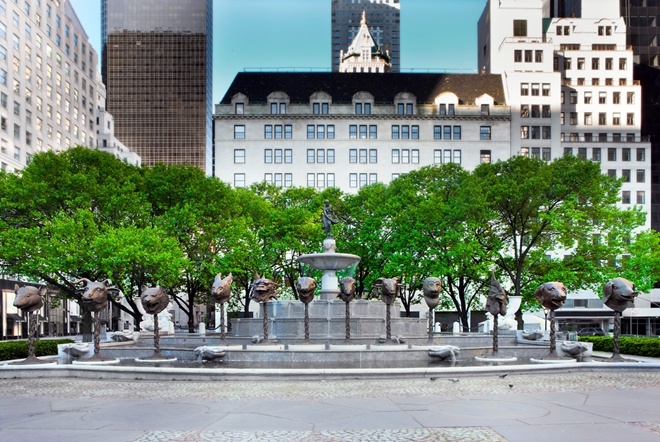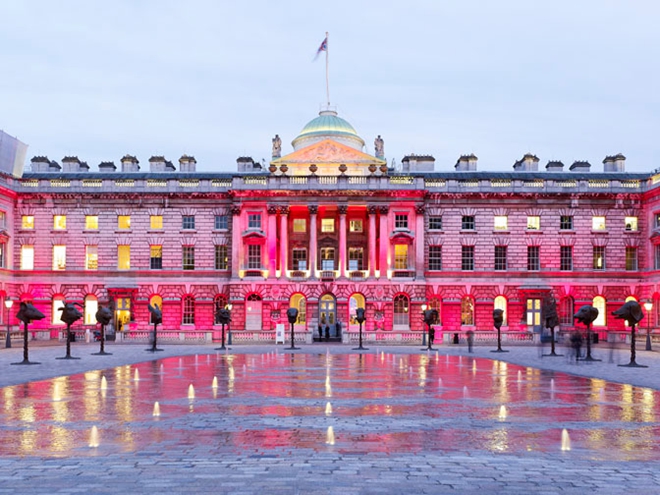Interview with Larry Warsh
In May 2011, Larry Warsh, an art collector and longtime friend of Ai Weiwei, installed Ai’s “Circle of Animals/Zodiac Heads” at the Pulitzer Fountain in Manhattan, New York. Since then the “Circle” has begun a tour of the world, including the courtyard of Somerset House in London.
“Zodiac Heads” is an oversized re-creation of the fountain in the (Old) Summer Palace, whose bronze heads were stolen when the palace was ransacked by British and French soldiers (among other countries) in 1860, with the pieces scattered around the world. Since then, only seven have been found, and five have been returned to China, including the pig bought by the Macau gambling magnate, Stanley Ho, in 2003 and later the horse in 2007 (reputedly for almost $9 million USD though this was never verified). Two further heads, the rat and the rabbit, were sold in the Yves St Laurent auction in 2009 but later withdrawn after the Chinese bidder, a buyer for China’s National Treasures Fund, refused to pay up on nationalistic grounds and so remain in the possession of St Laurent’s longtime partner, Pierre Berge. The ox, the tiger, and the monkey were bought successively by China Poly Group, which is owned by the People’s Liberation Army. Still missing are the dragon, the snake, the sheep, the dog, and the rooster, which in Ai’s version have been replaced with heads of his own devising.
Chris Moore: Could you tell us how you and Ai Weiwei met?
Larry Warsh: I met Ai Weiwei sometime around 2005 in Beijing. We had an instant connection. Ai Weiwei lived in New York City [where I live] for a decade, so there was a natural bond and a sort of understanding between us regarding art and culture. I have been collecting his work and collaborating with him ever since. He is a remarkable artist and truly a visionary human being.
CM: How did the idea for the “Circle of Animals/Zodiac Heads” develop?
LW: I had been thinking about public sculpture for some time, and I broached the subject with Ai Weiwei around early 2008. Of course, he was very interested in the concept. At first we just exchanged a lot of ideas and looked at a lot of works of public sculpture. Then he started visiting NYC to get a sense of the possibilities. The zodiac idea occurred to him around the time of the uproar over the Yves Saint Laurent sale at Christie’s, when two of the original heads went up for auction. The notion of creating oversized zodiac heads was a brilliant idea, one that relates very closely to Chinese history as well as contemporary political/social issues. From there we worked together closely to realize the concept and the actual creation and manufacture of the twelve zodiac heads. It has been an incredible process. The world tour for the “Circle of Animals/Zodiac Heads” is now in full swing, and we just this week confirmed the dates for the Taipei Fine Arts Museum exhibition of the “Circle of Animals/Zodiac Heads.” For additional information about this body of work please visitwww.zodiacheads.com.
LW: The “Circle of Animals/Zodiac Heads” was installed at the historic Pulitzer Fountain in NYC from May 4 to July 15, 2011. For the duration of the installation I had the chance to visit the heads many times, and it was always a thrill to see the exhibit in all its majesty. If I didn’t know anything about Ai Weiwei or his art, or the significance of this particular work as it relates to Chinese culture, I would still be awed by the zodiac animals and their installation at the Pulitzer Fountain. It was the first time in the history of the fountain (the Pulitzer Fountain is over one hundred years old) that public sculpture was allowed within the fountain.

《十二生肖/兽首》,纽约普利策喷泉,2011年5月。
CM: Can you describe your favorite time of day for viewing the “Zodiac Heads” at the fountain?
LW: My favorite time of the day to visit the “Zodiac Heads” was always in the early morning, when the city was just getting going. That early time of the day allowed for a more austere vision of the installation. At the Somerset House in London, however, I loved seeing the installation all lit up in the evening. Very impressive.
CM: Have you visited the Summer Palace?
LW: Yes, I visited the Summer Palace during my “research” trips to Beijing to get a better sense of the history and the scale of the Yuanmingyuan (Old Summer Palace) and the original zodiac heads.
CM: How has the meaning of Ai Weiwei’s “Zodiac Heads” changed since his incarceration and recent release?
LW: I feel the Zodiac Heads talk for Ai and create a public presence for the artist. Especially since he cannot travel right now, the exhibitions currently in place are so important as his voice. As I said, the “Zodiac Heads” were years in the making. It was always Ai Weiwei’s goal to have these works exhibited around the world. In some respect I believe his recent incarceration and release is unrelated to his work as an artist. Of course everything Ai Weiwei does is connected to his politics; however, the “Zodiac Heads” stand on their own as a testimony to Ai Weiwei’s unique creative voice. I would argue that Ai Weiwei’s “Zodiac Heads” have taken on a more significant meaning since his recent troubles with the Chinese authorities. His “Zodiac Heads” are in essence “free” to inspire people all across the globe.

《十二生肖/兽首》,纽约普利策喷泉,2011年5月。
LW: The “Circle of Animals/Zodiac Heads” was installed at the historic Pulitzer Fountain in NYC from May 4 to July 15, 2011. For the duration of the installation I had the chance to visit the heads many times, and it was always a thrill to see the exhibit in all its majesty. If I didn’t know anything about Ai Weiwei or his art, or the significance of this particular work as it relates to Chinese culture, I would still be awed by the zodiac animals and their installation at the Pulitzer Fountain. It was the first time in the history of the fountain (the Pulitzer Fountain is over one hundred years old) that public sculpture was allowed within the fountain.
CM: Can you describe your favorite time of day for viewing the “Zodiac Heads” at the fountain?
LW: My favorite time of the day to visit the “Zodiac Heads” was always in the early morning, when the city was just getting going. That early time of the day allowed for a more austere vision of the installation. At the Somerset House in London, however, I loved seeing the installation all lit up in the evening. Very impressive.
CM: Have you visited the Summer Palace?
LW: Yes, I visited the Summer Palace during my “research” trips to Beijing to get a better sense of the history and the scale of the Yuanmingyuan (Old Summer Palace) and the original zodiac heads.
CM: How has the meaning of Ai Weiwei’s “Zodiac Heads” changed since his incarceration and recent release?
LW: I feel the Zodiac Heads talk for Ai and create a public presence for the artist. Especially since he cannot travel right now, the exhibitions currently in place are so important as his voice. As I said, the “Zodiac Heads” were years in the making. It was always Ai Weiwei’s goal to have these works exhibited around the world. In some respect I believe his recent incarceration and release is unrelated to his work as an artist. Of course everything Ai Weiwei does is connected to his politics; however, the “Zodiac Heads” stand on their own as a testimony to Ai Weiwei’s unique creative voice. I would argue that Ai Weiwei’s “Zodiac Heads” have taken on a more significant meaning since his recent troubles with the Chinese authorities. His “Zodiac Heads” are in essence “free” to inspire people all across the globe.
CM: As a visitor to the Zodiac Heads, whether at the Pulitzer Fountain in Central Park or anywhere else, does it matter if you are Chinese or not?
LW: No, absolutely not. Ai Weiwei created the “Zodiac Heads” for everyone, especially children, to enjoy. People from all walks of life love animals and enjoy large outdoor sculpture. Although the original twelve zodiac animal heads are related to Chinese history, they are also just twelve magnificent and delightful animals heads, liberated of any deeper meaning.

《十二生肖/兽首》,伦敦萨默塞特宫,2011年5月。
CM: What do you want to see change, and do you think it will?

《十二生肖/兽首》,纽约普利策喷泉,2011年5月。
LW: I want to see everyone achieve his goals, succeed in his own way, and enjoy life in a harmonious world that allows for freedom of expression. I realize those are idealistic notions but we must still strive for our dreams and believe that humans are capable of realizing peace and prosperity.
CM: Which is your favorite head?
LW: I am a monkey sign, so of course I am fond of the monkey. Actually I don’t have a favorite. All twelve heads are powerful and interesting in their own individual way.
CM: Next time Ai Weiwei is in New York, where do you want to take him to dinner?
LW: Last time Ai Weiwei was in New York we enjoyed a hearty pastrami sandwich in midtown. Ai Weiwei is a genuine New Yorker at heart. Next time he comes to town perhaps we can dine somewhere in the East Village or even Chinatown. It depends on his mood and his appetite!
CM: And what’s next for the “Zodiac Heads”? Would you like to see it in the Summer Palace?
LW: A set of the Zodiac Heads are currently on display at the Taipei Fine Arts Museum in Taiwan. They will be exhibited in other Asian cities too, hopefully one day also to be shown in Beijing. Yes, the Summer Palace would be incredible, but of course it would only occur under the right circumstances, the right political climate, and with total respect to Ai Weiwei.